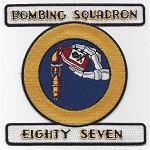Hobby Master HA2213 USN Curtiss SB2C-4E Helldiver ASW Aircraft - VB-87, USS Ticonderoga (CV-14), May 1945 (1:72 Scale)
"I once took off, and just after I left the deck my gunner, Russ Dustan, yelled "Hey George! Get this son of a bitch in the air!" and he pulled out his life raft because we were leaving a streak in the water behind us. I knew we were getting close. I was trying to scratch for altitude and get my gear up. When you're running out of speed and running out of room... it gets a little complicated at times."
- US Navy Ensign George Bomberger, pilot of a SB2C Helldiver aircraft aboard USS Franklin, late 1943
 The Curtiss SB2C Helldiver was an American aircraft carrier-based dive bomber aircraft produced for the United States Navy during World War II. It replaced the Douglas SBD Dauntless in US Navy service. Despite its size, the SB2C was much faster than the SBD it replaced. Crew nicknames for the aircraft included the Big-Tailed Beast (or just the derogatory Beast), Two-Cee and Son-of-a-Bitch 2nd Class (after its designation and partly because of its reputation for having difficult handling characteristics).
The Curtiss SB2C Helldiver was an American aircraft carrier-based dive bomber aircraft produced for the United States Navy during World War II. It replaced the Douglas SBD Dauntless in US Navy service. Despite its size, the SB2C was much faster than the SBD it replaced. Crew nicknames for the aircraft included the Big-Tailed Beast (or just the derogatory Beast), Two-Cee and Son-of-a-Bitch 2nd Class (after its designation and partly because of its reputation for having difficult handling characteristics).
Although production problems persisted throughout its combat service, pilots soon changed their minds about the potency of the Helldiver.
The large number (literally thousands) of modifications and changes on the production line meant that the Curtiss Helldiver did not enter combat until November 11th, 1943, with VB-17 on the USS Bunker Hill, when they attacked the Japanese-held port of Rabaul on the island of New Britain, north of Papua New Guinea. Even though the Helldiver entered U.S. Naval service, it still had such structural problems that the aircraft crews were forbidden to dive bomb in clean conditions (one of its main tasks). The SB2C-1 could deploy slats mechanically linked with undercarriage actuation extended from the outer third of the wing leading edge to aid lateral control at low speeds. The early prognosis of the "Beast" was unfavourable as it was strongly disliked by aircrews because it was much bigger and heavier than the SBD it replaced.
The litany of faults that the Helldiver bore included the fact that it was underpowered, had a shorter range than the SBD, was equipped with an unreliable electrical system and was often poorly manufactured. An oddity of the SB2Cs with 1942 to 1943-style tricolor camouflage was that the undersides of the outer wing panels carried dark topside camouflage because the undersurfaces were visible from above when the wings were folded.
Postwar, surplus aircraft were sold to the navies of France, Italy, Greece, Portugal and Thailand. Pictured here is a USN Curtiss SB2C-4E Helldiver anti-submarine warfare aircraft that was attached to VS-31 "Topcats", then operating out of NAS Atlantic City, New Jersey. Note that the dive brakes come in the open position.
Pictured here is a 1:72 scale replica of a USN Curtiss SB2C-4E Helldiver ASW aircraft that was attached to VB-87, then embarked upon the USS Ticonderoga (CV-14) during May 1945.
Sold Out!
Dimensions:
Wingspan: 8-1/4-inches
Length: 6-1/4-inches
Release Date: February 2018
 Historical Account: "Ticonderoga" - USS Ticonderoga (CV/CVA/CVS-14) was one of 24 Essex-class aircraft carriers built during World War II for the United States Navy. The ship was the fourth US Navy ship to bear the name, and was named after the capture of Fort Ticonderoga in the American Revolutionary War. Ticonderoga was commissioned in May 1944, and served in several campaigns in the Pacific Theater of Operations, earning five battle stars. Decommissioned shortly after the end of the war, she was modernized and recommissioned in the early 1950s as an attack carrier (CVA), and then eventually became an antisubmarine carrier (CVS). She was recommissioned too late to participate in the Korean War, but was very active in the Vietnam War, earning three Navy Unit Commendations, one Meritorious Unit Commendation, and 12 battle stars.
Historical Account: "Ticonderoga" - USS Ticonderoga (CV/CVA/CVS-14) was one of 24 Essex-class aircraft carriers built during World War II for the United States Navy. The ship was the fourth US Navy ship to bear the name, and was named after the capture of Fort Ticonderoga in the American Revolutionary War. Ticonderoga was commissioned in May 1944, and served in several campaigns in the Pacific Theater of Operations, earning five battle stars. Decommissioned shortly after the end of the war, she was modernized and recommissioned in the early 1950s as an attack carrier (CVA), and then eventually became an antisubmarine carrier (CVS). She was recommissioned too late to participate in the Korean War, but was very active in the Vietnam War, earning three Navy Unit Commendations, one Meritorious Unit Commendation, and 12 battle stars.
Ticonderoga differed somewhat from the earlier Essex-class ships in that she was 16 ft (4.9 m) longer to accommodate bow-mounted anti-aircraft guns. Most subsequent Essex-class carriers were completed to this "long-hull" design and were apparently referred to as the Ticonderoga class. At the end of her career, after a number of modifications, she was said to be in the Hancock class according to the Naval vessel register.
Ticonderoga was decommissioned in 1973 and sold for scrap in 1975.


